|
Yellowstone's
wild beauties
 Recently
we introduced you to the wonders of the world's first national park, the
Yellowstone National Park situated in the United States of America. Recently
we introduced you to the wonders of the world's first national park, the
Yellowstone National Park situated in the United States of America.
Its rich diversity and beauty leaves many a visitor breathless and
totally fascinated. Even though the park's geothermal features are a
major attraction, the fauna and flora too never fail to titilate
(stimulate) the senses of those who come to the park.
A wide variety of plant species are found at Yellowstone; it boasts
of around 1700 species of vascular (plants that contain tissue through
which food and water moves) plants and 85 species of conifer alone.
Today, we thought of featuring just a few of the beautiful flowers found
here. Even though they are not unique (one of its kind) they are rare
and a sight to behold.
Fairy Slipper
The name will no doubt immediately bring to mind a delicate looking
flower shaped like a fairy's slipper, we often
|
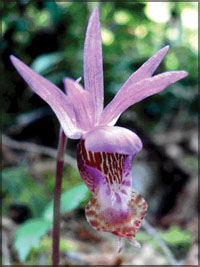
Fairy slipper
|
see in fairytale books. You are not wrong in picturing such a
flower because it really is shaped so, (as you could see in the picture)
and in fact , gets its name from the shape.
It is a very rare perennial (lasting more than two years) plant which
belongs to the orchid family. It is one of the 12 orchids found in this
area, and is considered endangered.
This fascinating terrestrial (land) orchid is native to North America
and Eurasia and is the only species in the genus (class).
It is found in Canada, Europe and various other parts of
USA.Considered the 'gem of the forest,' this beautiful flower is also
known as the Lady slipper, Venus slipper, Hider of the North and the
Calypso Bulbosa (in Latin).
According to history, the Latin name Calypso is given after the sea
nymph, Kalypso of Homer's Odyssey. It means 'covered or hidden from
view.' Like the nymph Kalypso, the plants too are beautiful and prefer
secluded areas. The word bulbosa means 'with bulbs.'
The Fairy slipper, which grows from a bulb and is a purplish-pink
flower, is about 1.5"- 2" in size, and has a height of 6"-8" inches. The
plant produces a single round leaf near the ground. The broad, basal
(low) leaf which has a crinkled look, dries up once the flower blooms.
It has a sheathed (covered) stem and a showy, drooping flower
comprising three sepals and three petals. While two petals look the
same, the centre petal is different. It is like a sac and is called the
lip by many. The flowering season is from May to June.
This striking and distinguished flower with a fresh, spicy fragrance
grows in wet, boggy coniferous woods or near decayed stumps and logs.
Wyoming paintbrush
|
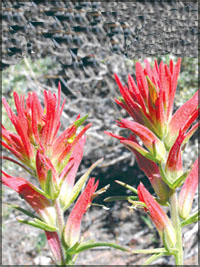
Wyoming paintbrush
|
A member of the figwart family, it is a parasitic (living off
another) plant that uses its roots to penetrate and steal nutrients and
water from other plants.
According to Inter-mountain Plan, about 200 species of paintbrush
plants mostly grow in North America, though several species are also
found in eastern parts of North America and Asia with 15 species growing
in Central South America alone. The flowers come in many colours and
often the colours represent distinct species.
The plant which also has medicinal value is protected in the park.
The flowers blossom in June through July.
The Wyoming paintbrush is usually tall for a paintbrush plant and
grows to a height of 18 to 36 inches. The common name for this plant is
Narrow leaf paintbrush.
It is also called the Sagebrush and Grass meadow. The plant favours
moist areas,
|
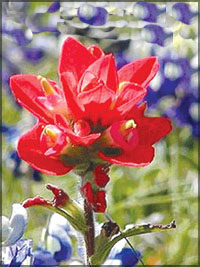
Wyoming state flower
|
but is drought tolerant too.
The plant is bright red and shiny and often the red portion is
mistaken for the flowers. But, they are actually the leaves.
The narrow, linear leaves with an alternate branching pattern hide
the flowers inside each of the loosely to densely clustered upper
leaves.
They form scarlet tubulars (tube like leaves) around the flowers
which too are tubular and yellow and green in colour. The flowers which
are not so attractive, protrude from the scarlet bract (leaf-like and
often brightly coloured part of plant, growing before the flower). The
stems range in colour from grey to green and crimson to purple.
In 1917 the Wyoming Legislature selected this species as the state
flower.
Elephant head
|
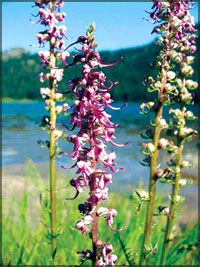 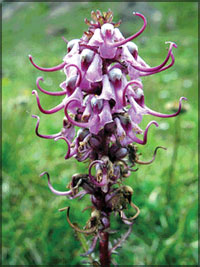
Elephant Head |
If you look closely at the picture featured here (on the left), you
would realise why this spike of tiny pink/purplish flowers which grows
in clusters, is so named. A member of the Snapdragon or figwart family,
the plant grows to a height of about three feet.
The flowers which are no more than 0.5" in length, not including the
trunk-like part, grows in a cluster at the top of the stem. The narrow,
green leaves which alternate along the stem resemble fern fronds (leaf
or leaf-like part) and grow to about 10 inches in length.
The plant usually grows in wet meadows and near cold streams at
elevations between 3000, to 10,000 feet.
Named after its shape which resembles miniature elephants, the
flowers bloom generally in August. The petals look like flared ears of
an elephant and an upward curved trunk. Some flowers are bright red.
It is also known as Bull elephant, Red elephant or Head little.
Yellow Monkey flower
An erect, slender stemmed annual plant currently placed in the
family, Phrymaceae, the Monkey flower is divided
|

Yellow Monkey flower
|
into two large groups of species. Also known as the Wide
throat, Mimulus or Musk flower, it is a highly diverse plant genus of
about 150 species.
With brilliant yellow flowers and the plant grows in variable heights
ranging from 4 inches to 32 inches.
The flowers which develop on a short stem, blossom from April to
July.
The flowers can be few to several in top clusters or solitary,
depending on the species.
The leaves too vary from irregular, ovate to rounded or kidney
shaped. The plant could be smooth or hairy, sticky or clammy and has a
two inch long corolla with a two-lobed upper lip. The calyx is
five-cleft and woolly, and about 3/4 of an inch long.
The plant is pollinated by different species of bumblebees in
different geographical regions. Though the plant provides a large amount
of pollen (fertilising dust or powder) it provides very little nectar as
a reward for insect visitors.
Glacier lilly
It is a perennial wild flower which belongs to the lilly family, and
is similar to the Avalance Lilly. It is commonly known as the Fawn lilly
and Dogtooth.
|

Glacier lilly
|
The flowers are cream to pale yellow or golden in colour, often with
a greenish tinge near the base and outer surface. They extend from a
single branchless stem which is about 35 cm in height.
The three to six petals which are bell shaped bend sharply backward,
and the flower seems to be drooping. The basal leaves are not mottled
(marked with blotches). They are narrowly to broadly oblong in shape.
Some believe that this flower, which is considered to be rather rare,
has only three real petals while the other three are only sepals that
resemble petals.
Flowers, in whatever shape, size or colour they bloom in, never fail
to capture our attention. They are generally a soothing sight and help
us to relax our minds.
They are a gift to us from Mother Nature and we should always protect
them because they are a part of our wonderful environment. We hope to
bring you more interesting facts about other beautiful wild flowers in
our future issue. |
